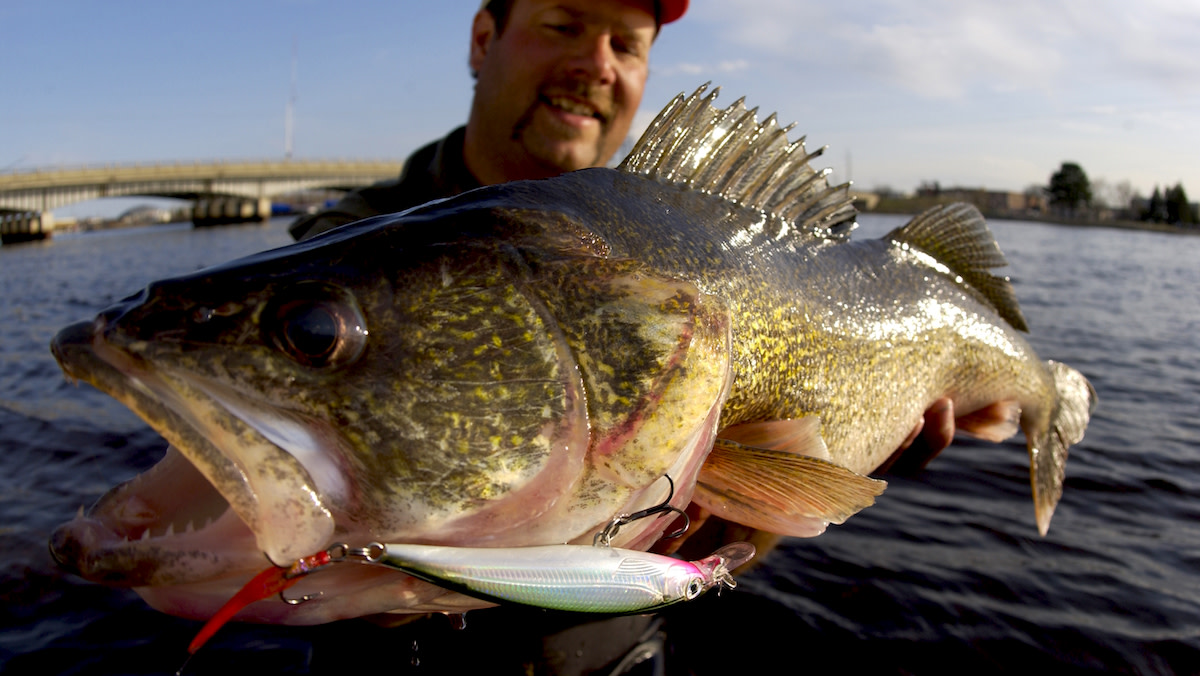
As lake ice and cabin fever begin to dissipate, you can bet the walleyes are getting restless too. This is the fishing version of the rut, and it’s arguably the easiest time of year to target walleyes. Before you get ahead of yourself, first you have to find them, then you need to know how to catch them.
Where to Find Spring Walleye
Walleyes’ exact location preferences seem to vary slightly from one body of water to another, but most of their preferred hiding places are strikingly similar. Walleyes tend to be in the current or places where food will predictably flow right to them. In the springtime, these areas also need to be in close proximity to spawning grounds.
Rivers
Walleyes like current both for spawning and feeding, which makes rivers and sunken channels in reservoirs golden highways in the spring. Look for areas with a transition from hard to soft bottom, such as rock to sand. Spots with a current break or some type of slack water or eddy also play huge roles. Structure such as rock piles, wing dams, or hard bends in a river all fit this mold.
Structure
Regardless of the lake’s size, rock piles and reefs play a crucial role in spawning. Think of a reef as both a cafeteria and playground. Spawning walleyes are often found near the crown or top of the structure. Staging or pre-spawn fish are typically found on the edges, whereas post-spawn fish are usually well outside the edges. It’s important to remember that the fish’s location relative to the reef is very much related to their activity level and desire to feed.
Flats
Rivers and reefs are common knowledge to hardcore walleye chasers but flats often get overlooked. For this reason, these are my favorite type of location to target. Instead of playing bumper boats with a hundred other anglers or getting good at tying knots from jigs lost in the rocks, flats are a great place to fish comfortably. Look for hard bottoms formed by compacted sand with either a mix of gravel, cobble, or zebra mussels. The most productive flats can often be found outside of a river bend or near shore adjacent a major point. Don’t be afraid to fish shallow. Sometimes shallow means 3 feet, other times it can mean 15.
How to Catch Spring Walleye
While this time of year can be one of the easiest to catch walleye, that doesn’t mean you can just throw a tin can out there and expect results. Walleyes’ mood and activity levels go up and down depending on what phase of the spawn they are in—and you need to adjust accordingly.
Jigs
The simple jig-and-minnow combination has probably accounted for more walleyes landed than any other rig. When fish are in pre-spawn patterns and hanging near the bottom, this combo is extremely effective fished vertically and very slowly, especially in rivers. When walleyes move out over the flats or onto the reefs themselves, actually casting the jigs covers more water and helps to avoid spooking fish.
While a lot of different styles of jigs will work, I have a couple favorites. The Northland Tackle Deep-Vee has a tapered head that works well in current, and the large eyes seem to function better when fishing vertically. An oversized hook and keeper allow you to use large minnows or a soft plastic tail.
When casting and working the jig back to the boat, the Fireball Long Shank is my go-to. The extra shank length allows you to thread minnows further for a more natural look. The longer hook helps keep minnows attached so you don’t have to add a new one after every cast. An extra eye also lets you easily add a stinger hook when the bites are very light or when you’re using supersized minnows.
Crankbaits
Big pre-spawn female walleyes that are in transit or staging near spawning grounds can be absolute suckers for a deep-diving crankbait such as the Northland Rumble Stick trolled over deep flats. Don’t be afraid to go big! Two-year-old minnows and baitfish from the previous year aren’t small, and walleyes are looking to bulk up. At this same time, males are typically sitting closer to the bottom and can be easily picked off near spawning grounds. In both cases, a deep diving crankbait is my weapon of choice.
When fish are deeper or a little more lethargic, don’t be afraid to switch to a shallow stickbait such as the Northland Rumble Shiner. Add a snap weight to get it deeper if necessary.
Worm Harnesses
As the spawn nears its end and the water warms, walleyes can still be found near their spawning grounds. Males will usually move out to deeper, adjacent areas and can be very aggressive. At this same time, females generally move a little farther away to deep mud basins to rest before making a move to their late spring territory. When this occurs, very few rigs work better than a crawler harness on a bottom bouncer. A quality bottom bouncer such as Northland’s Rock Runner lets you fish on or near the bottom without constantly hanging up. A floating crawler harness such as the Mr. Walleye Float’N Crawler Hauler provides both color and lift to get additional bites.
A walleye’s mood can go from zero to 100 and back down to zero in a matter of minutes. Knowing where to look for them and what to use in those active feeding windows can mean the difference between a fresh fish sandwich and having to tow the boat through the fast food drive-through on your way home.
Feature image via Bill Lindner Photography.




